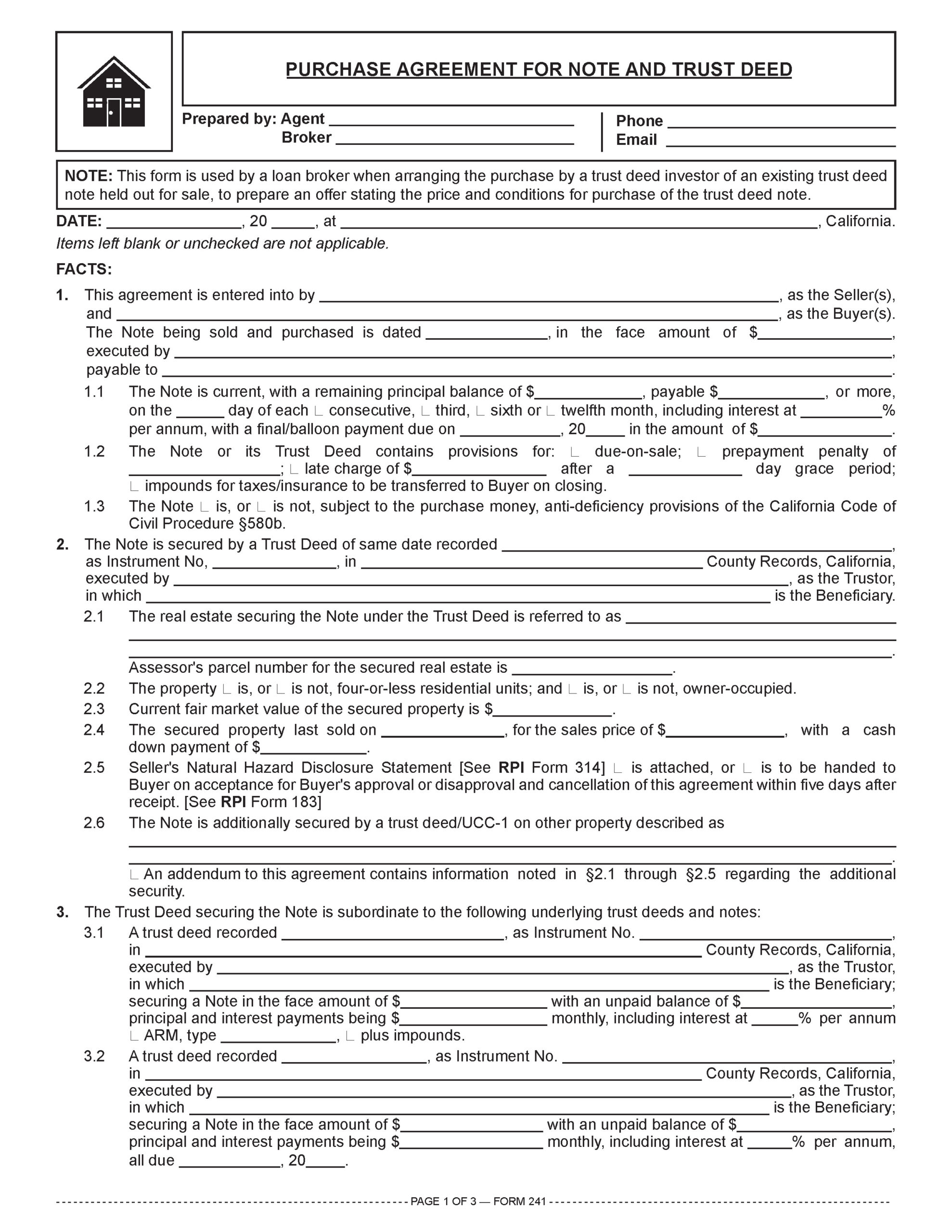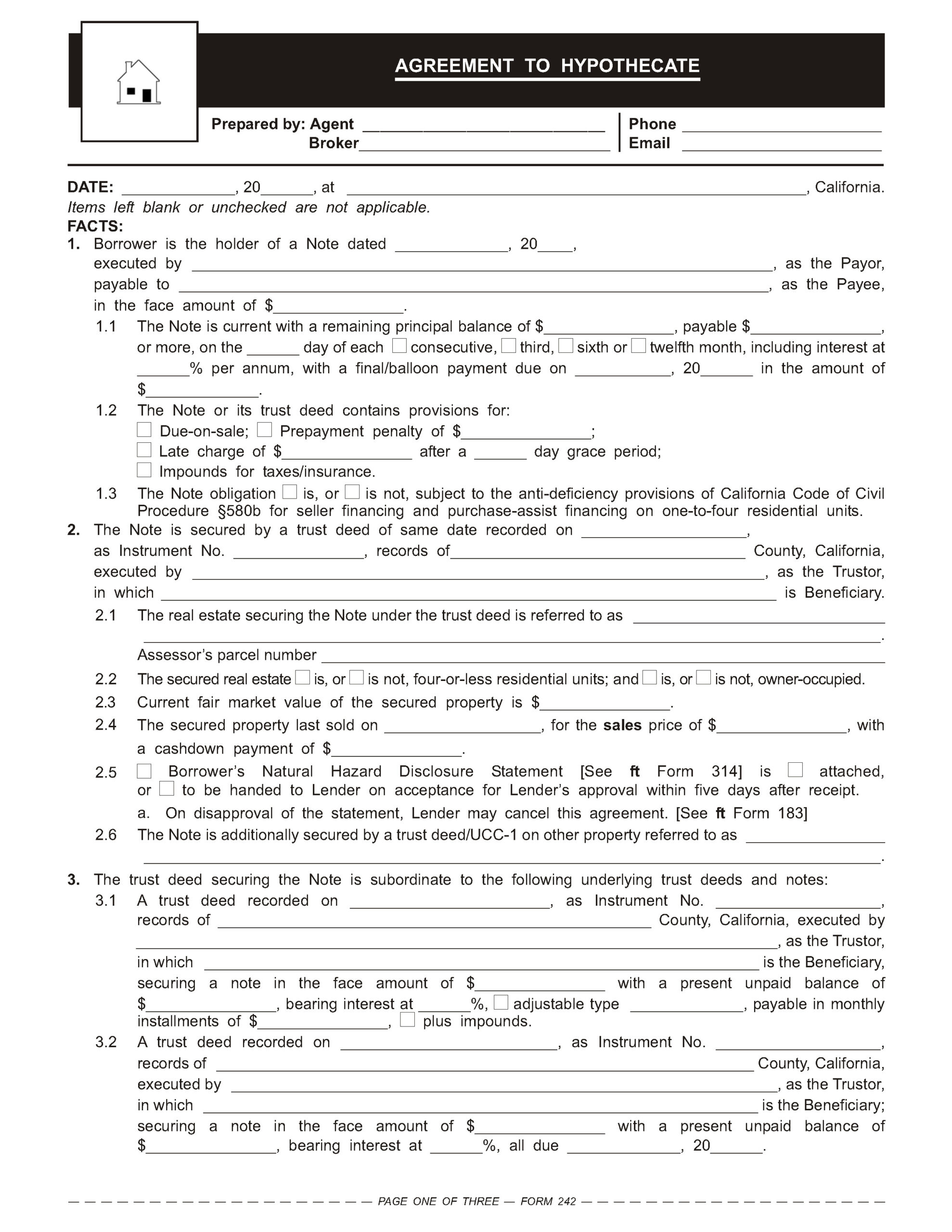Assignments of an existing note and trust deed
Brokers looking to expand their business need to consider arranging trust deed investments by soliciting cash-heavy individuals who invest in interest-bearing opportunities to consider trust deed note investments for greater annual earnings.
With higher yields than most corporate bonds and by setting low-risk LTV conditions, trust deed investors can invest directly in trust deed notes, sometimes called paper, rather than their purchase of lower yielding mortgage-backed bonds (MBBs). To invest in trust deed notes wholly independent of Wall Street’s MBB market, these investors need a trust deed broker to assist as an arranger of the trust deed investment:
- to make a loan evidenced by a note in favor of the investor and secured by a trust deed on real estate, a process called origination;
- to buy an existing trust deed note, called an absolute assignment [See RPI Form 241]; or
- to make a mortgage-backed loan (MBL) evidenced by a note in favor of the investor which is secured by the collateral assignment of an existing note and trust deed held by the borrower, called hypothecation. [See RPI Form 242]
In this Form-of-the-Week review, we limit the discussion to a broker arranging an investor’s acquisition of an existing trust deed note, or making an MBL collaterally secured by an existing note and trust deed.
Related video:
Stages of any trust deed note investment
The brokerage stages for arranging a trust deed (TD) investor’s purchase of a trust deed note or making a loan collaterally secured by a trust deed note includes:
- due diligence investigations;
- entry into a trust deed purchase agreement or agreement to hypothecate [See RPI Form 241 and 242];
- mortgage escrow instructions, funding and closing; and
- servicing, reconveyance and foreclosure.
During the due diligence stage of any trust deed note investment, the TD investor and their broker need to document and analyze the risks connected with:
- the payment history on the trust deed note purchased or collaterally assigned;
- the real estate directly or indirectly securing the investment (physical, title profile, income, location and value);
- the borrower’s creditworthiness, and on a collateral loan, also the property owner’s;
- the principal balance on existing mortgages on the property, including the trust deed note being assigned; and
- title insurance for the assignment.
Also, a trust deed broker typically has an inventory of available trust deed notes listed and fully packaged for delivery of information to a TD investor under a transmittal letter for consideration. [See RPI Form 233]
Related article:
The trust deed note as personal property
A negotiable instrument, such as a promissory note secured by a trust deed, contains an unconditional promise to pay a dollar amount as scheduled to the noteholder. A trust deed note is a negotiable instrument, and thus is either absolutely assigned – as in a purchase of a note – or collaterally assigned to a trust deed investor.
Buying or lending on a trust deed note, such as a seller carryback mortgage, is a reliable and profitable investment for trust deed investors, also called private money lenders or hard money lenders. [See RPI e-book Creating Carryback Financing, Chapter 6]
Comparable to a buyer of real estate entering into a purchase agreement with the advice and assistance of a competent transaction agent (TA), the trust deed investor buying a carryback note does so with the advice and assistance of their trust deed broker. [See RPI Form 241]
The investor’s broker gathers information provided by the noteholder prior to preparing an offer to purchase a trust deed note. Relevant information to be collected and reviewed with the investor includes:
- the terms in the trust deed note;
- the existing title policy insuring the trust deed (the collateral assignment is not insurable);
- the market value of the real estate securing the debt;
- a title profile on the real estate securing repayment of the note; and
- data on the real estate’s operating income and expenses when it is income-producing property.
Additional disclosures to be received and reviewed by the investor and their broker before closing include:
- a trustor’s offset statement from the owner of the secured property [See RPI Form 414]; and
- a beneficiary statement from each holder of trust deed notes encumbering the property. [See RPI Form 415]
When the mortgage being purchased is carryback paper, all the disclosures and agreements from the sale are also obtained from the seller and reviewed to determine both:
- the sufficiency of the property as security; and
- the quality of the note and trust deed.
Further, the investor and their trust deed broker review the hazard and title insurance policies which cover risks of loss and the conditions of title surrounding the existing trust deed. An appraisal of the property’s value is also appropriate to ensure it functions as sufficient security, as though the investment were the origination of a mortgage.
Related article:
The purchase agreement to acquire a trust deed note
At some point in the gathering and review of information on the trust deed note, property and title conditions, the broker prepares a note and trust deed purchase agreement. [See RPI Form 241]
A TD broker uses the Purchase Agreement for Note and Trust Deed published by Realty Publications, Inc. (RPI) when arranging the purchase by a trust deed investor of an existing trust deed note held out for sale. The form allows the broker to prepare an offer stating the price and conditions for purchase of the trust deed note. [See RPI Form 241]
The Purchase Agreement for Note and Trust Deed contains provisions describing:
- the terms and identity of the note being purchased, such as the payment schedule and the existence of a final/balloon payment, due-on clause or prepayment penalty provision [See RPI Form 241 §1];
- the real estate securing the debt, including its current fair market value (FMV), the type of property and whether it is owner-occupied [See RPI Form 241 §2]
- any senior encumbrances of record [See RPI Form 241 §3];
- the terms of the purchase of the note, such as the price to be paid [See RPI Form 241 §4];
- escrow details [See RPI Form 241 §§6 and 7];
- the title insurance company to be used to insure the recorded assignment of the trust deed [See RPI Form 241 §9];
- cancellation terms [See RPI Form 241 §16]; and
- the brokerage fee to be paid, which is nearly always paid by the seller of the paper. [See RPI Form 241 §17]
Related article:
The agreement to hypothecate
A loan broker uses the Agreement to Hypothecate published by RPI when arranging a loan made by a trust deed investor collateralized by an existing trust deed note held by the borrower. The form allows the loan broker to prepare an offer by the investor for the borrower’s acceptance stating the terms and conditions for making the collateralized loan. [See RPI Form 242]
The Agreement to Hypothecate contains provisions describing:
- the existing trust deed note [See RPI Form 242 §§1 and 2];
- the real estate securing the note, including its current FMV, the type of property and whether it’s owner- or tenant-occupied [See RPI Form 242 §§2.1 through 2.6];
- senior encumbrances [See RPI Form 242 §3];
- the terms of the collateralization of the note, such as the purchase price [See RPI Form 242 §4];
- escrow details [See RPI Form 242 §§7 and 8];
- the title insurance company to be used [See RPI Form 242 §9];
- cancellation terms [See RPI Form 242 §16]; and
- the brokerage fee to be paid. [See RPI Form 242 §18]
Related article:
Want to learn more about receiving and splitting broker fees? Click the image below to download the RPI book cited in this article.

















